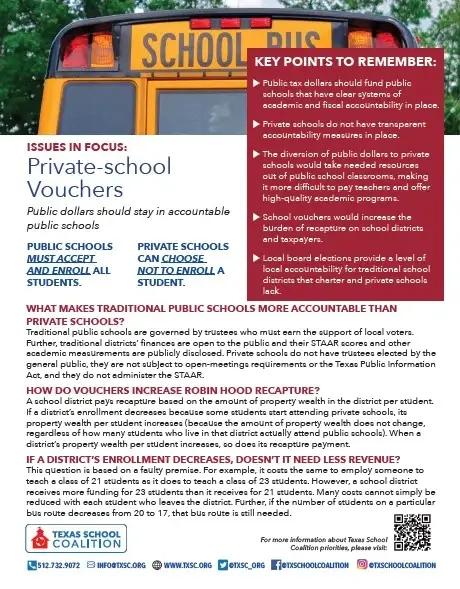KEY POINTS TO REMEMBER:
- Public tax dollars should fund public schools that have clear systems of academic and fiscal accountability in place.
- Private schools do not have transparent accountability measures in place.
- The diversion of public dollars to private schools would take needed resources out of public school classrooms, making it more difficult to pay teachers and offer high-quality academic programs.
- School vouchers would increase the burden of recapture on school districts and taxpayers.
- Local board elections provide a level of local accountability for traditional school districts that charter and private schools lack.
WHAT MAKES TRADITIONAL PUBLIC SCHOOLS MORE ACCOUNTABLE THAN PRIVATE SCHOOLS?
Traditional public schools are governed by trustees who must earn the support of local voters. Further, traditional districts’ finances are open to the public and their STAAR scores and other academic measurements are publicly disclosed. Private schools do not have trustees elected by the general public, they are not subject to open-meetings requirements or the Texas Public Information Act, and they do not administer the STAAR.
HOW DO VOUCHERS INCREASE ROBIN HOOD RECAPTURE?
A school district pays recapture based on the amount of property wealth in the district per student. If a district’s enrollment decreases because some students start attending private schools, its property wealth per student increases (because the amount of property wealth does not change, regardless of how many students who live in that district actually attend public schools). When a district’s property wealth per student increases, so does its recapture payment.
IF A DISTRICT’S ENROLLMENT DECREASES, DOESN’T IT NEED LESS REVENUE?
This question is based on a faulty premise. For example, it costs the same to employ someone to teach a class of 21 students as it does to teach a class of 23 students. However, a school district receives more funding for 23 students than it receives for 21 students. Many costs cannot simply be reduced with each student who leaves the district. Further, if the number of students on a particular bus route decreases from 20 to 17, that bus route is still needed.

